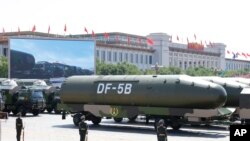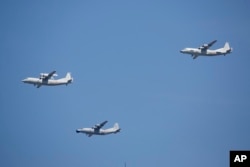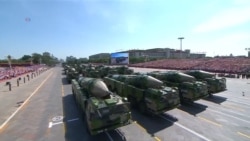The massive military parade in Beijing this week showcased China’s latest weapons, unveiling many to the public for the first time. But weapons experts say the systems on display showed hallmarks of China’s reputation for stealing technology and adapting it to its requirements.
The show involved long, medium and short range missiles, a range of tanks and 200 fighter aircraft. The Chinese government said that all the equipment had been made indigenously, attesting to the success of the country’s military industrial capability and the estimated $145 billion spent on the military in 2015.
“The parade was a bazaar of stolen intellectual property,” said Michael Raska, senior fellow at the Singapore-based Institute of Defense and Strategic Studies.
The researcher said it is possible to identify components and designs in different equipment, which have been sourced from other countries in a dubious manner.
Cloned technology
Citing a specific example, Raska said, “The HQ-6A launchers that we saw at the parade are based conceptually on the cloned Italian Alenia Aspide missile, itself which is based on the US RIM-7E/F Sparrow.”
Raska said the Chinese J-15 naval fighter is based on adaptation of Russia’s Sukhoi Su-33.
The United States has repeatedly accused China in recent years of cybertheft of U.S. technology and weapons systems on a grand scale. U.S. defense contractors have alleged that China’s J-31 stealth fighter is largely based on stolen technology of the U.S. F-35.
The United States last year said that Chinese army hackers had stolen trade secrets from six U.S. nuclear, steel and clean-energy companies, directly resulting in “substantial” loss of jobs, competitive edge and markets.
“This is a case alleging economic espionage by members of the Chinese military… to advantage state-owned companies and other interests in China,” then-U.S. Attorney General Eric Holder said.
But Raska said China has passed the stage where they were “emulators and copiers” and reached what experts describe as the point of “IDAR,” which means identify, digest, absorb and reinvest technologies.
Mix-and-match
Analysts said it is not easy for countries and companies that produced an original technology to prove that it was stolen by China. Component designs are mixed and matched across different categories of weapons before they are remodeled and manufactured in China.
China may also be using its diplomatic relationships with countries that have acquired Western weapons and do not mind passing on acquired technologies to Chinese scientists.
But even with such technology sharing from countries friendly with China, Jagganath Panda, a research fellow at the Institute of Defense Studies and Analysis, said the country’s investments in its military have paid off.
“We need to accept that China has been hugely successful in developing a strong military industrial production capability,” he said.
In recent years China has sold drones, warships, submarines and air defense systems to developing countries, becoming the world’s third largest arms exporter behind the United States and Russia.
Indeed, one major point of Thursday’s military parade may have been to display the country's newest advanced systems to interested buyers, and bolster China’s reputation as an emerging military power.
WATCH: Related video report by William Ide













